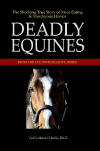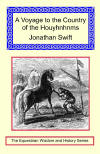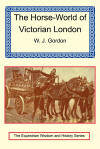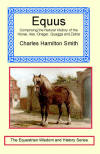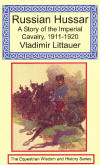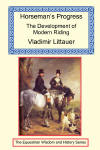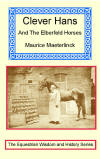The Equestrian Wisdom and History Literary
Collection
It has been argued that when you deprive people of words you restrict their thoughts, deny their inspiration and diminish their possibilities of life. Sadly the equestrian words and ideas which could inspire and change lives in the 21st century seem to have fallen out of fashion. This alarming development has been encouraged by the disappearance of essential equestrian titles from the past, and a lack of academic investigation in the present. The result has been the dawning of an age of collective equine academic amnesia, one wherein great authors are forgotten and new authors are neglected.
In contrast to the academic works and equine discoveries brought about in the late 19th century by the mutual efforts of noted equine scientist Cossar Ewart and world-travelled equestrian author, Horace Hayes, too many of today’s equine works are indicative of the equestrian narcissism of the West, with its preoccupation with outmoded and harmful equestrian methods based on western Europe’s misunderstanding of the horse and an outdated allegiance to the charade of mounted nobility.
There is an equal danger from the rise of modern self-styled experts who are interested in labels, not ideas, and who promote the increasing bourgeoisification of the horse.
Together they have combined to create equine works of mind-numbing opaqueness, in a language of turgidity, designed to promote the outdated myths and plodding prejudices inherited from European, Roman and Greek pedestrian origins.
This has brought about the nadir of intellectual equestrian investigation, one where many of today’s equine authors have abandoned the practice of sceptical inquiry in favour of a misguided preference to an idealized past.
The Long Riders’ Guild’s new Equestrian Wisdom and History series is designed to re-publish the most important equestrian books previously written, as well as publishing indispensable new works by the world’s leading equine academics, equine investigative journalists and riders. There are approximately one hundred titles scheduled for production and the books will be available in a host of languages.
For more information regarding forthcoming titles, or to suggest a title for this literary collection, please contact The Long Riders’ Guild Press.
Here are the titles currently available in this exciting new collection.
| Deadly Equines: The Shocking
True Story of Meat-Eating and Murderous Horses CuChullaine O'Reilly
|
There is widespread belief in a warm and comforting story which states the horse is a gentle herbivore. What if a Rosetta Stone had been found to unlock the dark secrets of the horse’s past? An international multi-million dollar industry serviced by horse whisperers, glossy magazines and popular culture preaches that horses are meek prey animals who fear predators. What if evidence demonstrated horses have slain lions, tigers, pumas, wolves, hyenas and humans? Contemporary writers have successfully airbrushed murderous and meat-eating horses out of literature. What if Shakespeare, Sherlock Holmes and Steve McQueen provided artistic evidence to refute that claim? Thanks to global equestrian amnesia, the crucial role played by horses in recent history has been lost to mankind. What if testimony revealed meat-eating horses had been used to explore the Poles and photographs had been discovered of Tibet’s blood-eating horses? Deadly Equines is a revolutionary departure from equestrian romance. It is a fact-filled analysis which reveals how humanity has known about meat-eating horses for at least four thousand years, during which time horses have consumed nearly two dozen different types of protein, including human flesh, and that these episodes have occurred on every continent, including Antarctica. Various sources of corroborating data, including legends, literature, cinema, news stories, scientific reports and eyewitness accounts are presented for the reader’s investigation. None of these items had been hidden. They were ignored, misinterpreted or, in some cases, censored. The result is the first exploration of the horse’s hidden history, an alternative equestrian world populated by forgotten facts, overlooked evidence and astonishing stories. Amply illustrated, and containing a map of occurrences, this study challenges the reader to develop a new understanding of the horse, one based upon reason, not fantasy. For more information and images, and to read the Editorial Reviews, please click here. |
| A Voyage to the Country of
Houyhnhnms Jonathan Swift
|
According to legend, when the author and Historical Long Rider Jonathan Swift made an equestrian journey across Ireland, he arrived at a remarkable conclusion. The beloved mare who carried him faithfully was a paragon of reason, understanding and sympathy, unlike his fellow human beings. At the conclusion of the ride, Swift penned his famous book, Gulliver's Travels. It told the tale of Lemuel Gulliver, a ship’s captain who sailed to four remarkable kingdoms. While the simple children’s version focuses on the little people of Lilliput, it was the talking horses found in the fourth adventure which outraged civilised English society. A Voyage to the Country of the Houyhnhnms recounts how Captain Gulliver’s crew mutinied and set him ashore on an unknown island. There he encountered a race of savage humanoids who threatened to kill him. The bewildered traveller was rescued by horses, who it turns out could speak and in fact ruled the island. What follows is an astonishing tale that turns man’s definition of himself on its head. The naked, warlike and murderous humans are known as Yahoos, a term still used today as a synonym for "ruffian." In order to draw attention to the evils of materialism and elitism, Swift described the Yahoos as savage creatures with selfish habits, who are obsessed with digging pretty stones from the mud. In stark contrast the Houyhnhnms, which in their language means "the perfection of nature," are a race of intelligent horses that enjoy a peaceful society based upon reason. Though he is biologically akin to the Yahoos, Gulliver prefers the company of his benevolent equine hosts. When he learns to converse with the horses, Gulliver attempts to explain human society. His equine hosts are perplexed with the alien concepts of greed, war and injustice. Nor do they have a word for ‘lie,’ and must substitute the phrase “to say a thing which is not.” When Gulliver reluctantly returns to England, he finds the company of his countrymen, whom he now views as Yahoos, so intolerable that he spends most of his time in the stable near his home. Thus, this equine episode is the keystone of Gulliver's Travels and reflects Swift’s disenchantment with popular society. Originally it was believed that A Voyage to the Country of the Houyhnhnms was a metaphor used by Swift to highlight England’s treatment of slaves as lesser human beings. More recently, it has been described as an early example of animal rights, in that Gulliver’s role reversal highlighted how cruelly English horses were treated. First released anonymously in 1726, it sold out in less than a week. Since then, the challenging tale has never been out of print. Nor has there arrived a human who has answered the challenge Swift wrote for his own epitaph. “Go forth, Voyager, and copy, if you can, this vigorous champion of Liberty.” For more information, please visit Amazon.co.uk or Barnes & Noble. |
| The Horse-World of Victorian
London by W. J. Gordon
|
If it was true
that the sun never set on the British Empire, it was equally true that it
employed millions of equine subjects to defend, feed and maintain social
order among its human citizens. Originally released in 1893, “The Horse
World of Victorian London” provides an insight into the city’s incredible
lost equestrian world. At the dawn of the 20th century, there were an
estimated 300,000 horses living and working within the city limits of Great
Britain’s capital. We are not speaking of horses lodged in farms in the
nearby country who travelled in and out the city. Ironically, though the
city streets were thronged with horses, few of them were used exclusively
for riding. This was instead a massive four-legged work force, the likes of
which today’s mechanised humans can neither remember nor relate to. For
example every year London’s tram horses collectively travelled twenty-one
million miles through the crowded city streets. An estimated forty thousand
carriage horses pulled father to work and the children to school. Mother
went shopping on the omnibus, of which 22,000 horses drew more than 2,000
vehicles every day. If the family couldn’t afford a carriage, they could
always travel by horse-drawn tram. London had 135 miles of horse drawn tram
lines. Every year these tram horses collectively travelled twenty-one
million miles through the crowded city streets. The North Metropolitan Tram
Company alone employed 3,500 horses. Before the days of UPS and FEDEX,
private companies delivered household goods to the family home from nearby
railway stations. One company maintained 2,000 horses, which they kept
stabled at twenty depots strategically placed around the great metropolis.
The concept of rental cars has its roots in the London stable too. The
Tilling Corporation maintained an inner-city herd of 2,500 horses which they
rented to anyone, including washerwomen, the fire brigade and police.
Meanwhile, the sturdy coal horses kept everyone warm by moving an average of
thirty tons of coal a week. The accommodations for this enormous urban herd
were as varied for the horses as the humans who employed them. Horses lived
in everything from tiny huts in dark alleys to multi-storied stables which
held several thousand horses under one roof. The doctor, the duke and the
drayman all relied on hard-working horses, who routinely laboured ten hours
a day for six days a week. From the Lord Mayor to the beggar boy, the horse
influenced the daily lives of every Londoner. The nineteenth century was the
golden age of the horse and this well-illustrated book serves as a unique
guide through London’s vanished equine world. For more information, please visit Amazon.co.uk or Barnes & Noble. |
|
Whisper on the Wind - The Story of Tom Bass, Celebrated Black Horseman by Bill Downey 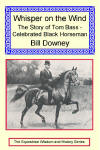
|
Before Jackie Robinson ever donned a Dodger uniform - there was Tom
Bass. Before Rosa Parks ever demanded a seat in the front of the bus - there
was Tom Bass. Before Martin Luther King ever had a dream - there was Tom
Bass. Before Barack Obama ever ran for President - there was the legend of
Tom Bass - the black horse whisperer. Born a slave, Tom Bass rose to the
summit of what had always been a white man's profession, the training of the
America's greatest Saddlebred horses. At nine years old this Mozart of the
equestrian world used his extraordinary natural talent to teach an outlaw
mule who couldn't even be handled to canter backwards. An advocate of
gentleness and patience, Bass turned dangerous horses into reliable mounts -
without ever raising his voice or using a whip. His immense knowledge of
equine psychology allowed the man who had been born in a slave cabin to
invent a revolutionary and humane bit, still in use today. Yet Bass's
greatest achievements were in the saddle, not in the training ring. What he
was able to entice horses to do defies belief. His consummate skill and
immense empathy with horses allowed him to produce horses of such exquisite
proficiency that their accomplishments are still remembered today. Buffalo
Bill's famous white horse, Columbus, was one such legendary talent. Bass was
able largely to transcend the race barrier because he was accounted the
greatest horseman of the late nineteenth century. The first black American
ever to ride in Madison Square Garden, in an age when racial segregation
ruled the nation, Tom Bass was the mounted friend of five presidents of the
United States, including Teddy Roosevelt. Upon Tom's death in 1934, his name
was a household word, synonymous with equestrian feats of unparalleled
beauty and achievement. Then his story faded into oblivion, until this
fascinating biography of America's most remarkable black horseman was
rescued from the shadows. Please visit Barnes & Noble or Amazon.co.uk to buy a copy of this book. |
| Equus - The Natural History of the Horse, Ass, Onager, Quagga and Zebra
|
Before the advent of machines, horses ruled supreme. They were the solace and servant of mankind in a life still devoid of railroads and automobiles. Thus in a world dominated by horses, the appearance of a book containing humanity’s collective equine knowledge marked an important event, especially as this was no example of obsolete scholarship. Though published in 1841, the book more accurately reflected the eighteenth century, with its total reliance on equines, rather than the technological fascination characterizing the emerging Victorian era. The resulting book, written by the period’s most imminent equine naturalist, was a masterpiece of Equus erudition. An English soldier turned scientist, Charles Hamilton Smith was concerned that the public was being misled by erroneous accounts or the absence of accurate information. To rectify this error, he set about enabling equestrian essentials to emerge from obscurity, thereby authoring a book which became the principal authority on all aspects of horse-related wisdom. Smith consulted, translated and transcribed every type of original texts, including works in Greek, Latin, Arabic and many Oriental sources. Nor was any topic off limits. Rare legal records detailing Welsh laws against horse abuse were unearthed. An early genetic examination of curly haired horses in Columbia was presented. Eyewitnesses were interviewed who had seen wild sultan-stallions attacking predators in Central Asia. Yet the mounted author’s most astonishing accomplishment was the careful documentation of more than a hundred ancient and extinct breeds, including the Katschenstzi of Tartary, a shining black horse with a white mane and the Sardinian wild horse, an indigenous animal not imported by man. Sadly, despite the book’s incredible research and resources, it was doomed to be eclipsed by a rapidly-changing social landscape. The result is that this new edition is an equestrian time capsule, complete with the lost expertise of another age. With a Preface by modern Britain’s renowned equestrian historian, Dr. Elaine Walker, this timeless book also contains Smith’s original colour prints of ancient, rare and extinct equids. To buy a copy of this book, please visit Barnes & Noble or contact the LRG-AF |
| Russian Hussar |
Vladimir Littauer served in the Russian Imperial Cavalry from 1911 to 1920. This book recounts, with humour and modesty, his experiences as a cadet at the Nicholas Cavalry School in St. Petersburg, through the hair-raising struggles of the First World War and the trauma of the Russian Revolution, to his escape in 1920. By the time you turn the last page, you will feel as if you have galloped beside the author through the early years of his amazing life. As Sir Robert Bruce Lockhart writes in the Foreword, this is quite the best book on its subject ever written, and is essential reading for anyone with an interest in cavalry warfare, life under the Czar or European military history. Littauer arrived in the United States in 1921, and shortly thereafter founded the famous Boots and Saddles Riding School in New York. For the next sixty years he taught successive generations of riders and teachers, and revolutionised riding in the United States and overseas. He wrote ten books on equitation and training, all of which are full of long experience, a deep love of horses, and plenty of common sense. For more information, please go to Amazon.co.uk or Barnes & Noble |
| Horseman's Progress |
This book presents the story of educated riding since its inception four centuries ago. Vladimir Littauer relates in a most entertaining way how dressage was improved; how forward riding was developed by an Italian cavalry officer and how the new natural method for field riding and jumping swept dressage into the background. It is a gold mine of accurate, intelligent, and authoritative instruction – much more than mere history. The book is divided into four parts which show how the customs and ways of life in different periods have affected the horseman's progress. Court, cavalry and sport have all had their influence. Littauer also discusses modern riding in Italy, France, Germany, England and the United States and each country's contribution to the development of riding. The vista that unfolds in the development of modern riding will fascinate those who ride, teach or compete. Vladimir Littauer was an officer in the Russian Imperial Cavalry and fought on horseback in the First World War and the Revolution. His knowledge and understanding of horses is unsurpassed, and he writes with humour and common sense. Horseman’s Progress is essential reading for anyone who is interested in the history of horsemanship and who wants to obtain a better relationship with his horse.
For more information, please go to Amazon.co.uk or Barnes & Noble |
|
Clever Hans and the Elberfeld Horses
|
In the early days of the 20th century, the world was agog to learn that a German stallion named Clever Hans could apparently communicate with humans. The discovery of this remarkable animal, who could supposedly also spell and tell time, caused such an uproar that the German government appointed the “Hans Commission” to investigate the astonishing claims. With the New York Times and other papers anxiously awaiting the outcome, the Commission concluded in September, 1904 that no tricks were involved. A sceptical psychologist however declared that the horse’s owner was guilty of inadvertently signalling the answers to Hans. The result was an impassioned debate, one which resulted in a wealthy German businessman named Karl Krall announcing he had trained three other horses which were smarter than Hans. These horses could not only solve complex mathematical calculations and recognise people, he said, they could also transmit the correct answer to questions via the newly-invented telephone. Plus, to offset scientific critics, one of Krall’s horses was blind! In the midst of this equestrian scientific brawl, the Nobel Laureate, Maurice Maeterlinck, announced he was going to travel from his Belgian home and personally inspect these educated German horses. Having been granted complete freedom to test the horses in a variety of ways, he concluded, “You rub your eyes and ask yourself in the presence of what new creature you stand. You look for some trace, obvious or subtle, of the mystery. You feel yourself attacked in your innermost citadel where you held yourself impregnable.” Was it all a colossal fraud? The psychologists, who have spent a hundred years denouncing Clever Hans and Karl Krall’s horses, are still quick to say it was. Yet even their denunciation wasn’t originally unanimous. In a detailed report, Edmund Sanford, one of America’s founding psychologists, reluctantly admitted that he could not conclusively denounce the horses’ scholastic abilities. With the outbreak of the First World War it all became a moot point, as the horses were slain and the majority of the original documents were lost to posterity. This is the first modern attempt to re-examine the mystery of Clever Hans and his fellow educated horses. This ground-breaking study includes Maeterlinck’s original eye-witness observations, extracts from Karl Krall’s rare German book explaining how he trained the horses to achieve such remarkable results, and Sanford’s detailed psychological report. The mystery of Clever Hans and Krall’s horses still intrigues equestrian scholars and this analysis will provide vital information designed to reconsider the startling question – can horses communicate with humans?
To buy this book, please visit Barnes & Noble or Amazon.co.uk. |
